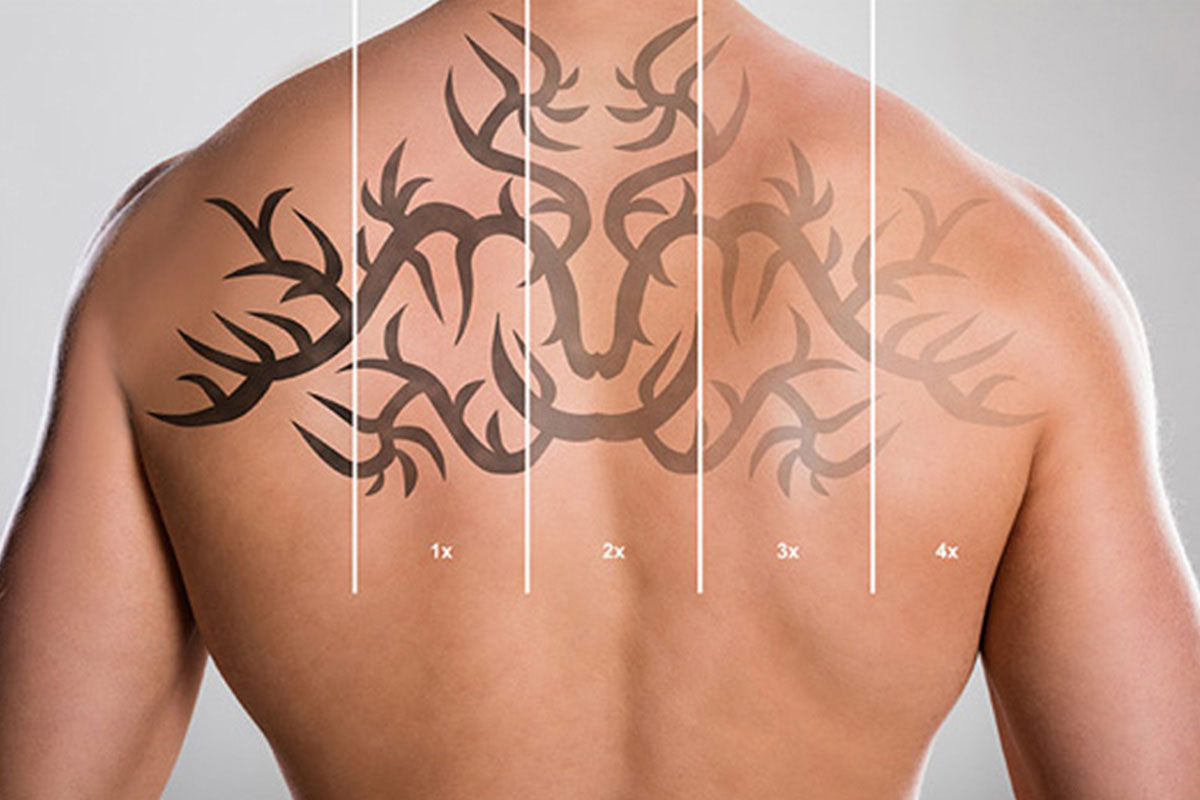Tattoos are often personal expressions of art and identity, but as life evolves, so do our preferences. Whether it’s a change in personal style, a career move, or just the desire for a fresh canvas, tattoo removal has become an increasingly popular option.
However, the process of removing a tattoo is not as simple as getting one. It involves multiple sessions, each with its own nuances and challenges.
In this article, we’ll delve into the full details of tattoo removal and answer some burning questions about how many sessions it takes to bid farewell to an unwanted inked memory.
Table of contents
How Many Sessions to Remove a Tattoo?
Removing a tattoo is a process that requires careful consideration and understanding of various factors. The number of sessions needed to remove a tattoo can vary widely based on several factors, including the size, color, type of ink, the tattoo’s age, and the individual’s skin type. Here are the full details on how many sessions it typically takes to remove a tattoo:
Tattoo Size and Complexity:
- Small Tattoos: Small tattoos can often be removed in fewer sessions, ranging from 3 to 6 sessions on average.
- Large Tattoos: Larger tattoos with more ink and complexity may require 10 or more sessions to achieve complete removal.
The Tattoo Color and Type of Ink:
- Black Ink: Tattoos with black ink are generally the easiest to remove and usually require fewer sessions.
- Colored Ink: Colored tattoos, especially those with vibrant and varied colors, can be more challenging to remove and may require additional sessions.
Tattoo Age:
- New Tattoos: Older tattoos tend to be easier to remove, as the ink may have already started to break down naturally over time. New tattoos may require more sessions.
- Old Tattoos: Tattoos that have been in place for several years can often be removed in fewer sessions.
Skin Type:
Individuals with lighter skin tones typically respond better to tattoo removal treatments, and the process may require fewer sessions.
People with darker skin tones may require additional sessions and need to be cautious to avoid hyperpigmentation (darkening of the skin) during removal.
See also: How Tall is Jack Skellington? All the Facts and Details
Tattoo Removal Method:
Laser Tattoo Removal: This is the most common and effective method for tattoo removal. The number of sessions required depends on the type of laser used, the tattoo’s characteristics, and the individual’s skin response. Typically, it takes several sessions, usually 5 to 15 or more, spaced several weeks apart.
Other Methods: Alternative methods like dermabrasion, surgical excision, or creams are less common and may have varying success rates. The number of sessions required can differ significantly based on the method chosen.
Healing Time Between Sessions:
To allow the skin to heal and the body to flush out fragmented ink particles, it’s essential to space removal sessions 4 to 8 weeks apart. This also helps minimize scarring and discomfort.
Read also: 26 Legitimate Ways to Get a Costco Student Membership for Free
Expectations and Realistic Goals:
It’s important to set realistic expectations for tattoo removal. Some tattoos may not be entirely removed and may only fade or leave faint outlines. Consult with a qualified specialist to discuss your goals and the estimated number of sessions required.
Tattoo removal is a complex process that depends on various factors. The number of sessions needed can vary widely, but patience and persistence are key. Consult with a professional tattoo removal specialist to determine the best approach and develop a realistic plan for achieving your desired results. Understanding the factors that affect the process will help you make informed decisions about tattoo removal.
Check out: What Do Guys Like to Be Called? (Top 25 Names)
Why do Tattoos Require Multiple Removal Sessions?
Tattoos are designed to be permanent, with ink embedded in the deeper layers of the skin. This makes it challenging to remove the ink completely in a single session. Tattoo removal methods need to target different layers of ink to be effective.
Tattoos often contain a mix of colors and ink types. Different colors and types of ink respond differently to removal treatments. Certain colors, like black ink, are easier to remove, while others may require more sessions. Varied colors necessitate multiple sessions to address each color effectively.
Tattoos are often created in layers, with new layers of ink added over old ones. This layering makes it necessary to target each layer individually, often requiring several sessions to break down and remove all ink layers.
The need for multiple removal sessions is primarily due to the complexity of tattoos, the various factors affecting ink removal, and the importance of patient safety and well-being throughout the removal process. Tattoo removal specialists carefully plan the number of sessions required based on the tattoo’s characteristics and the individual’s skin, ensuring the best possible outcome while minimizing potential side effects.
Read also: What Does GMS Mean on Snapchat?
Can all Tattoos be Completely Removed?
Not all tattoos can be completely removed, and the success of tattoo removal depends on various factors, including the tattoo’s characteristics, the removal method used, and individual factors. Here are some key considerations:
- Tattoo Size and Complexity: Smaller and less complex tattoos are generally easier to remove completely compared to large and intricate ones.
- Ink Colors: Some ink colors, particularly black ink, are more responsive to removal treatments, making it easier to remove tattoos that consist primarily of black ink. Vibrant or varied colors can be more challenging to erase.
- Type of Ink: The type of ink used can affect removal. Professional-grade tattoo ink is more challenging to remove than homemade or amateur ink, which may not penetrate the skin as deeply.
- Tattoo Age: Older tattoos tend to be easier to remove, as the ink may have already started breaking down naturally over time. Newer tattoos may require more sessions.
- Individual Skin Type: Individuals with lighter skin tones tend to respond better to removal treatments, while those with darker skin may require more sessions and are at greater risk of hyperpigmentation (darkening of the skin) during removal.
- Tattoo Layering: If a tattoo has been layered with new ink over old ink, each layer may need separate treatment, which can extend the number of sessions required.
- Tattoo Fading vs. Erasure: In many cases, tattoo removal leads to fading rather than complete erasure. Some tattoos may leave behind faint outlines or “ghost images.”
- Removal Method: The choice of removal method matters. Laser removal is the most common and effective method, but other methods like dermabrasion or surgical excision may yield different results.
Check out:: 26 Legitimate Ways to Get a Costco Student Membership for Free
Conclusion
Tattoo removal is a journey that requires patience and persistence. The number of sessions needed to remove a tattoo varies widely, influenced by factors such as the tattoo’s size, ink colors, and the individual’s skin type.
When considering tattoo removal, it’s crucial to consult with a qualified specialist to determine the best approach and set realistic expectations for the process. Tattoo removal is a path to new beginnings, but it’s important to be well-informed about the journey ahead.
Frequently Asked Questions
The number of sessions required to remove a tattoo depends on several factors, including the size, color, and type of ink used, as well as the age of the tattoo and the individual’s skin type. In general, most tattoos require multiple sessions, often ranging from 5 to 15 or more for complete removal.
Tattoos are designed to be permanent, with ink embedded in the deeper layers of the skin. Tattoo removal works by breaking down the ink particles so that the body’s immune system can gradually eliminate them.
The waiting period between tattoo removal sessions is typically around 4 to 8 weeks. This allows the skin to recover and the body to clear away the ink particles broken down during the previous session. The timing may vary based on the specific removal method used and the advice of your dermatologist or tattoo removal specialist.
While significant advances have been made in tattoo removal technology, not all tattoos can be completely removed. Factors such as the tattoo’s age, size, color, and type of ink used can affect the success of removal.
Various methods are used for tattoo removal, including laser removal, dermabrasion, and surgical excision. Laser removal is the most common and effective method. The choice of removal method and the number of sessions required can depend on the tattoo’s characteristics.
References
- paradisemedspas.com– how many sessions to remove a tattoo
- removery.com– how many sessions to remove a tattoo
- wikihow.com– how many sessions to remove a tattoo






